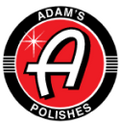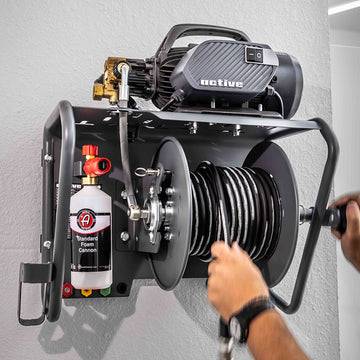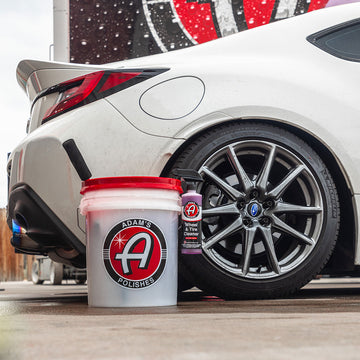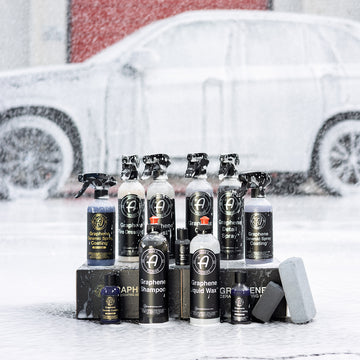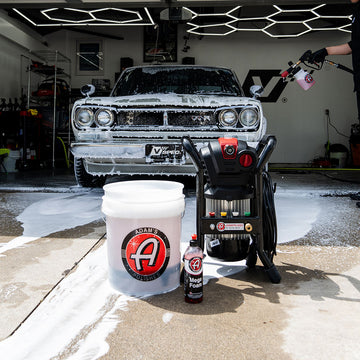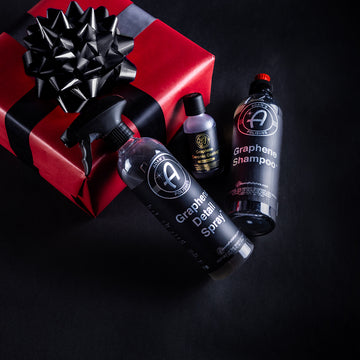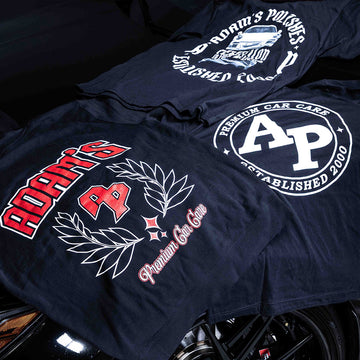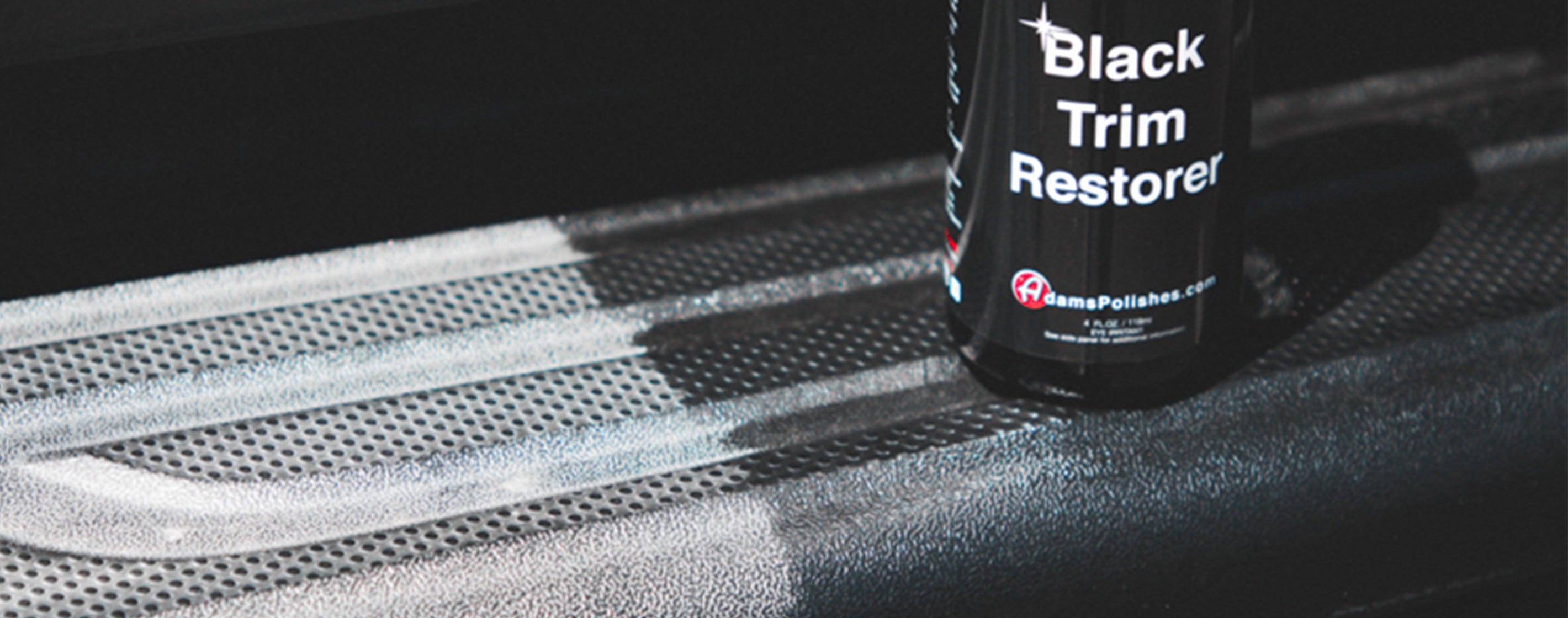| Paint Protection: What, When, and Why? |
Which is right for you?
Sealants, glazes, waxes, and ceramic coatings - in the world of car care there are a number of options when it comes to protection and enhancement of your vehicles exterior. Differing in longevity, durability, and gloss enhancement, all of these forms of protection serve a purpose. But what should you be using? While this question is largely preference based, or finance driven, there certainly is a right choice for you depending on how your vehicles are used, stored, and ultimately what your goals are for the finish.
UNDERSTANDING YOUR OPTIONS
Each type of product provides unique benefits and some level of compromise. Understanding what benefits are part of each type of product and choosing your LSP (Last Step Product) or maintenance products is important. Ultimately, each person needs to strike their own personal balance between 3 aspects:
Longevity = how long the product lasts and how well it protects the underlying clearcoat.
Appearance = the visual impact the product provides in terms of added gloss, depth, etc.
Hydrophobic Properties= the intensity of water beading and sheeting you will achieve.
Glazes:
Durability: Very Low | Aesthetics: High | Hydrophobics: Low to Medium |
Glazes are probably the least understood product considered a part of the LSP category. The term glaze has been used and misused widely over the years by a number of manufactures, but most professionals have come to accept that a glaze is most commonly a non-abrasive product used to mask imperfections and provide surface enhancement.
Most glazes will be a blend of a few basic ingredients - carnauba/montan wax, solvent, and oils. These three components are blended in a ratio to allow them to help fill in minor imperfections and thanks to the solvent content even offer a level of paint cleansing.
Glaze has long been a favorite product of car lots all over the world since they offer fast, easy, and inexpensive enhancement of painted surfaces in one step. However, the short lived effects have left more than a few new car owners wondering why their recent purchase looked so awful after just a few washes.
Ultimately glazes are best suited as a compliment to another LSP or used only for short term enhancement after a fresh paint correction. The blends rarely lend themselves to more than a week of longevity in mild conditions and they're often easily washed away or evaporate when exposed to medium to moderate heat.
In spite of their short lifespan on your vehicle’s finish, a glaze can offer fast, easy, and dramatic enhancement of gloss and depth making them a great choice as a topper right before a show, cruise, or whenever you want a little extra 'pop' on your finish. Glazes commonly will lend low to medium hydrophobic property enhancements as they smooth the surface to a slick finish-- It’s more stability than enhancement more than anything
Adam’s Polishes offers a crowd favorite in this category, and one of our longest tenured products… Adam’s Brilliant Glaze. Brilliant Glaze features a blend of T1 Carnauba Flakes, mild solvent, and oils to quickly haze over a surface on application and leave a brilliant finish behind. This solvent-based product achieves a wet look on single stage, clear coat, and gel coated surfaces. Brilliant Glaze fills very minor scratches and cuts through mild surface oxidation on paint, chrome, glass, and finished surfaces.
Waxes:
Durability: Low to Moderate | Aesthetics: High | Hydrophobics: Medium to High |
Wax is commonly comprised of naturally occurring substances, harvested from a specific type of palm tree, commonly known as the detailing world as Carnauba and Montan wax. Carnauba wax comes in a variety of pureness, grades, and can be refined to various levels. Its blended with oils, other wax types (like bees wax), and in some cases even some polymers to create car wax. Carnauba is a hard and coarse substance that has to be blended to create a chemical suitable for application to a vehicle - so be skeptical of any product claiming to be 100% carnauba. By emulsifying the flakes in separate stage of blending, products are able to achieve higher levels of carnauba concentration, but 100% would be rendered useless for the detailing world. The makeup of carnauba would make it almost impossible to spread over your paint if it isn't cut with various other ingredients. See the magnified picture of raw carnauba wax below for a better idea why no car wax can be truly 100% carnauba.
Blending various waxes, solvents, oils and polymers together can give you virtually an infinite number of combinations and types of car wax, but there are some limitations no matter how good the blend. These limitations center mostly on how susceptible to deterioration from heat, detergents, and abrasion wax is. Even the best grades of carnauba will have a melting point between 160-180 degrees F, meaning a black car parked outside on a summer day in a climate like Arizona will easily begin to see evaporation of wax coating, within just a few days, or even a few hours the wax will be completely gone. Users in this sort of climate might find themselves more keen to a sealant or a Silica Resin-infused option like out Ceramic Paste and Ceramic Liquid Wax. These options are purely made from synthetic, man-made ingredients gear driven towards higher heat tolerance and overall a “tougher” option.
The biggest benefit to natural waxes is their overall enhancement to painted finishes. A good wax will enhance colors, fill minor imperfections, and produce a rich, deep look that typically won't be seen with other LSP options. On dark colors (blacks and blues) you'll see additional depth and dimension. On brighter colors (yellows and reds) you may notice a more rich, vibrant look. Given that they are derived from plants, they are glossy and protective by nature and provide a dramatic aesthetic enhancement. As waxes contain oils and polymers, they will fill in peaks and valleys of your paint’s microscopic surfaces, creating a glossier finish and a highly reflective surface. In doing so, the surface has much less surface energy, allowing water to bead and sheet off easily.
Adam’s Polishes offers a few maintenance items in this wax category, but most commonly used are Spray Wax and Detail Spray for both basic wipe downs and drying aids after a proper two bucket wash. Just like Brilliant Glaze, Spray Wax features a blend of T1 Carnauba Flakes separately emulsified and then blended into the remaining mixture to quickly wipe away streak free and leave a brilliant finish behind.
Sealants:
Durability: Moderate to High | Aesthetics: Low to Moderate | Hydrophobics: Medium to High |
Sealants tend to be mostly synthetic man made products chemically engineered to do very specific things, but mostly they excel at providing durable protection. Because these products are essentially created in a lab they can be modified, customized, and engineered to meet any number of criteria and perform in different ways.
On average a sealant will provide better durability than a comparable wax product. With much higher resistance to heat, UV, and detergents an application will withstand more abuse. Sealants encompass a wide variety of chemical compounds including acrylic resins, polymers, and aminos. Some will include varying amounts of wax in their blend to aid in filling or adding gloss. In more recent technological advancements, we are able to adapt Silica Resins into blends and mixtures, creating a ceramic-like performance with the ease of use of a sealant.
For years sealants fell behind waxes in terms of providing aesthetic enhancement, but more recently sealants have been bridging that gap, offering better durability and an ever increasing levels of gloss and depth. While a sealant hasn't quite been able to recreate the rich depth found from carnauba based products the gap separating the two is increasingly smaller. Most sealants currently on the market offer excellent clarity and reflective properties making their look ideal for colors that don't typically benefit from waxes like metallic silver and white. Sealants withhold a strong hydrophobic potential as they also fill in and bond to the peaks and valleys of your painted surfaces, reducing surface tension and letting water roll right off.
Adam’s Polishes offer two unique products in this category that are simply in a league of their own. Adam’s Paint Sealant is an easy-to-use synthetic paint sealer that is based on acrylic polymer technology. This soft, cream-like product will protect your paint, wheels, or other painted exterior surfaces for months! The UV blockers carefully maintain the gloss, shine, and reflective properties of your finish while deflecting like in different ways when left out in direct sunlight. This product can be applied by hand or machine, and should applied before waxes or glazes to ensure a hearty bond with the clear coat surface. This is a color-coded system for use with our Grey Foam Wax/ Sealant pads or our microfiber applicator. During application, this product thinly spreads out across the surface and sets up within 3-5 minutes before removal. The unique blend of polish agents and acrylic polymer resins make it extremely easy to remove and leave behind a brilliant finish. This formulation provides a durable protective layer to any painted surface and is built to withstand the harshest seasons and elements.
Once applied after a thorough wash and clay bar application, this formula is easily applied and can further be maintained with our H2O Guard & Gloss, color-coded for ease of use. By maintaining your Paint Sealant with H2O Guard & Gloss, the longevity is drastically increased and looks as though you’ve applied a fresh layer each time! It is important to note that a thorough layer of Paint Sealant before is recommended for best results.
Ceramic Coatings:
Durability: Extremely High | Aesthetics: Extremely High | Hydrophobics: Extremely High
Let’s set something straight… In the car care industry, ceramic coatings and “nano” technology have become buzzwords and industry standards and although sometimes effective, these are not true “ceramic” coatings. Having silica resins, or “containing SiO2” doesn’t make it a true ceramic coating. Containing ceramic technology is the minimum to passing the first audition in modern car care, but is it an actual ceramic coating? Unfortunately, no. Consider our Ceramic Boost or Ceramic Paste Wax: Both contain heavy amounts of SiO2, give extreme amounts of gloss and protection, and are extremely hydrophobic, but not actual coatings! They are designed for ceramic maintenance in between washes, or an alternative to conventional carnauba/polymer waxes. With Adam’s Ceramic Paint Coating or Spray Coating, the proof is in the application— The first swipe of the product will reveal a quickly appearing “rainbow” effect, there's your proof! This is not a streak, smear, or defect— The rainbow effect is a mixture of gases and liquids evaporating and curing to your finish to provide the hydrophobic, acid-resistant, water spot-resistant, and UV inhibiting layer that we’re all after. As the rainbow effect begins to widen and develop, the applied product is turning to evenly hardened SiO2, or glass— hence “glass” coatings. Now, this chemistry is unique to our current coatings as it has a longer working time, allowing it to tack up not as quickly and let you cover an entire hood, as opposed to small sections or proportions.
The most recent technology for exterior protection is found in the coatings category. Once a product only for professionals the detailing world has begun to see more consumer friendly products that offer previously unheard of longevity and various other benefits. Described as nano coatings, glass coatings, or ceramic coatings the chemicals used in this category offer durability spanning multiple YEARS rather than months with some even claiming permanent protection.
Coatings can almost be thought of as a clear coat for your clear coat. They form a hard, clear, cured, hydrophobic barrier that is more resistant to scratches than automotive clear coat and even prevents contamination from sticking making them easier to clean.
What makes a ceramic coating, a ceramic coating?
Hang tight, we’re going to get scientific with you— Ceramic coatings start with silica resins, ones that are usually cured in a furnace or extreme heat, but are modified versions to cure at room temperature (ie your garage or detail shop!).
The ceramics we’re used to are the modified versions and are neatly ordered and paired molecules of Si and O that make a tetrahedron, which produces a perfect triangle contributing to its stability and strength on your paint. The Si and O molecules are so strong in fact that their bonds don’t step out unless abrasion and/or heat are introduced, hence why Ceramic Coatings only come off with time or accelerated polishing!
When we released our first ceramic coating back in 2016, we saw the results were exceptional and quickly trumped any conventional wax or sealant. As we have created and infused products with SiO2 and silica-resins to feed the protective layer what it wants, we interchangeably built confusion into our customers not knowing what and what not could be used on their vehicles. With this grouping of products and the ceramics family, we have found our way of simplifying the process from confused to concise, changing the results better to best. We have created comfort in coating your vehicle without any doubt of what product to use on it in any case.
Ceramic coatings are the ultimate in protection for your vehicle’s finish. Outlasting any natural waxes, synthetic sealants, and achieving the highest gloss levels, ceramic coatings protect against micro-marring, swirl induced washing, and make water bead like crazy on the surface. You’ve already made the investment into your vehicle to go through and perfect the paint on your car and protect with the top tier in products, but once you applied this durable coating, you can’t just walk away and forget about it.Although superior to conventional waxes, ceramic coatings do require general upkeep from time to time to keep them performing like the day we applied it. In a way, it can weaken over time and your investment can be jeopardized through lack of upkeep. In this segment, we’ll teach you what symptoms to look for in your coating, why it’s important to properly maintain your ceramic coating, how you can do so, and how often you should keep up with maintenance.
The original use of ceramics were primarily driven to be under heat to create a hard, rigid surface like porcelain. Ceramic coatings are derived from the similar chemistry, except it's made from a microscale nanoparticle, instead of a macroscale particles— meaning it’s smaller scale and able to be extremely detail oriented. Once applied those particles bond, crosslink and transfer within each other to create sacrificial layer that has literally become one with the surface. As time goes on and the coating comes into contact with more and more elements, the properties that originally made the coating so strong and profound take a chance at wearing down. Instead of reaching for any of our premium car care products, we have separated each and every product needed to maximize your coating into its own segment. Basic wipe downs after a car show become calculated and beneficial to your coating with Ceramic Waterless Wash, a Sunday car wash now extends the life of your coating with Wash & Coat in unison with Rinse & Coat. A ceramic coating requires exceptional preparatory work to be worthwhile, so why not continue to feed it with everything it needs to be long-lasting.
The products in this category continue to evolve offering an increasingly diversified amount of benefits, with some coatings being easier to apply, others offering better scratch resistance, and others even focusing on some amount of gloss enhancement like a wax. The coating market is still very young and continues to evolve.
It should be mentioned that there is some level of skill involved in a coating application as well. A finish should be completely corrected prior to a coating application simply because any defects still in the paint will be trapped beneath the coating. Additionally coatings have specific cure times and techniques - be sure to research the application and requirements for any coating before attempting to apply yourself.
So Which One is Right For You?
There are no specific rules for choosing a product to use on your particular car, but there are some clear frontrunners to choose from simply by looking at how you use/store your vehicles mixed with your overall desire for increased shine.
For outright show car looks it’s hard to beat a wax. Its ideal for a car that spends most of its days in the garage or lives in more mild climates. A wax still continues to be the ultimate choice for someone looking to get the most 'shine' out of their finish. While sealants and coatings continue to find new levels of shine they still don't quite measure up to the look of a quality carnauba paste wax.
On the other hand a sealant or even a coating might make sense for your car if its a daily driver or its exposed to extreme winters or very hot summers. If you're among the large percentage of people who have to drive their car every day, even when the weather is less than perfect durability and ease of maintenance are your primary concerns. Ultimately you want to keep your car protected from the elements - so for a driver or car stored outside explore the options of sealants and coatings.
Ultimately, the choice of what is best is up to you. Find a product or products that have the right mix of the durability and enhancement for your budget and your free time. Afterall, if you just enjoy the process of cleaning and waxing your car then a wax is going to give you the most excuses to rub on it. There’s no rule you can't apply a wax to your daily driver or a sealant to your garage queen, but understand that you might not be seeing the full benefit of your product choice if its not ideal for the conditions its exposed to.
LAYERING MULTIPLE PRODUCTS
What if you want the best of both worlds? Well, you could venture into the world of layering. Working with a couple of product types in specific layers can give you a number of benefits, so long as you apply them properly.
As a general rule, the most durable product should always be used as the base, so for example if you were working with a sealant and a wax, the sealant would be your base layer that is then topped with the wax. The only exception to this rule comes into play with a combination of glazes and wax. Because wax doesn't bond to the paint in the same manner as a sealant or a coating a glaze can be used UNDER a wax to maximize the filling ability of the glaze without compromising the longevity of the wax coat.
The flip side of layering different products is in the top coat performance. Remember that whatever is applied last will be what outward behavior you see most. So when you top a coating with wax you will notice the aesthetic benefit, but you might also notice that the surface isn't as hydrophobic as it would've been with just the coating alone.
The best thing to do is to experiment for yourself to see what you like. With so many possible combinations there's going to be a process that suits you best, finding it is just a matter of trying them and evaluating for yourself.
MULTIPLE LAYERS OF THE SAME PRODUCT
If some is good, more must be better? Right? That might not always be the case. Many products will stack a few layers deep for additional surface coating, but there is a point of diminishing returns. A wax for example will max out at about 2 thin coats, attempting to put 5 coats of wax down in search of extra gloss and super durability just doesn't work. The additional coats simply begin to smear the base coats around and can actually have a negative impact on the clarity of the finish. The same is true of glazes for the most part.
Sealants, while more apt to layer without issues, still only stack a few layers deep before they begin to offer no additional benefit and you begin wasting product. Our independent testing showed no noticeable benefit for a panel treated with 2 coats of sealant vs a panel treated with 4 coats.
“Can I layer ceramic coatings to make it last longer?” Yes, of course, but that doesn’t mean layering this product 10 times will make it 10x longer— any application after 3 rounds will render the product redundant and still provide the same hydrophobic effects. With coatings, the tricky part of their curing process and the specific type of coating. Some coatings require substantial cure time before an additional layer can be applied, others require additional layers be applied before the first is fully cured to bond properly as the cured coat will actually repel the 2nd coat. Refer to your specific coating technology for guidance if you intend to layer.
